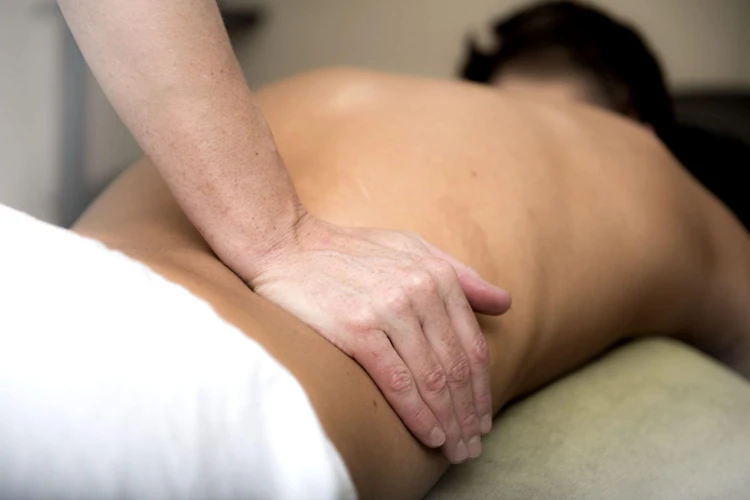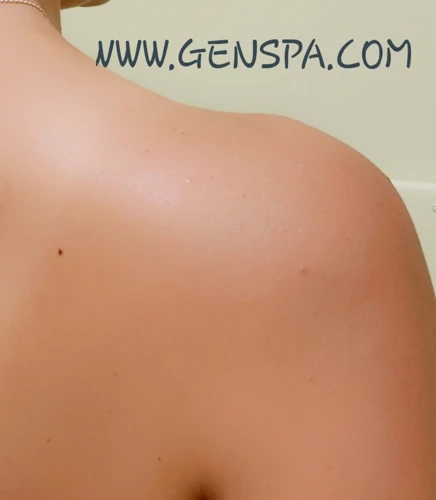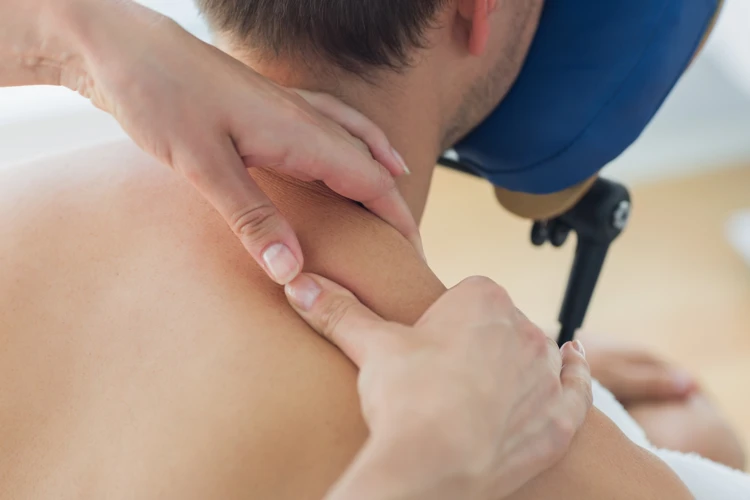If you are looking for a way to help relieve the pain and discomfort caused by a pinched nerve, then massaging the area can be beneficial. This step-by-step guide will show you how to massage a pinched nerve to help provide relief from the pain and discomfort. By following this guide, you’ll be able to reduce the pressure on the nerve and help it heal.
Contents
What is a Pinched Nerve?

A pinched nerve is a condition in which a nerve is compressed or irritated, which causes pain and discomfort. It can be caused by a variety of factors such as a slipped disc, bone spurs, or inflammation. The most common area for a pinched nerve is the neck, which can cause pain and numbness in the arms or hands.
Symptoms of a pinched nerve in the neck include:
- Neck pain
- Numbness and tingling in the arms or hands
- Weakness or loss of strength in the arms or hands
- Muscle spasms
- Headaches
If left untreated, a pinched nerve in the neck can cause permanent nerve damage and chronic pain. Massage therapy is a safe and effective way to relieve the pain and discomfort associated with a pinched nerve in the neck.
How to Massage a Pinched Nerve in Neck:
It is important to use caution when massaging a pinched nerve in the neck. If you have any concerns, it is best to consult a massage therapist or medical professional before attempting to massage a pinched nerve in the neck.
- Gently place your hands on either side of the neck and apply light pressure. Your hands should be in line with the spine.
- Massage the muscles on either side of the neck and spine in a circular motion. Use gentle, slow pressure and avoid pressing too deeply into the muscle.
- Move your hands up and down the neck, working on the muscles near the base of the skull. Use light pressure and focus on areas that are particularly tender.
- Massage the shoulders and upper back in the same manner, using gentle circular motions.
- Once you have finished massaging the neck and shoulders, take a few moments to relax and take slow, deep breaths.
Massage therapy can be a great way to relieve pain and discomfort from a pinched nerve in the neck. Remember to be gentle and take your time when massaging a pinched nerve in the neck.
Causes of a Pinched Nerve

- Injury or Trauma: Direct trauma to a nerve, such as a bone fracture, can cause a pinched nerve. Other injuries, such as a herniated disc or arthritis, can also cause a pinched nerve.
- Overuse: Repetitive motion, such as typing, using a mouse, or playing a musical instrument, can cause inflammation that leads to a pinched nerve.
- Tumors: Tumors in the spine can compress nearby nerves and cause a pinched nerve.
- Infection: Bacterial or viral infection can cause swelling and inflammation in the spine, leading to a pinched nerve.
When it comes to the shoulder, the most common causes of a pinched nerve are from repetitive motions, such as those involved in certain jobs or sports activities. Other causes of a pinched nerve in the shoulder include rotator cuff injuries, shoulder blade misalignment, or a herniated disc in the neck.
Symptoms of a Pinched Nerve

A pinched nerve is usually the result of a compression of a nerve from surrounding tissues, such as bones, cartilage, muscles or tendons. The signs and symptoms of a pinched nerve depend on the location of the nerve and the extent of the nerve compression. Common symptoms of a pinched nerve include:
- Tingling or burning sensation in the affected area
- Pain that radiates outward from the affected area
- Numbness or difficulty moving the affected area
- Weakness in the affected area
In some cases, a pinched nerve can also cause a sharp, shooting pain that is felt in the affected area. The pain may be worse when the affected area is moved or when pressure is applied to the area.
Benefits of Massaging a Pinched Nerve

- Reduces Pain and Discomfort: Massaging the affected area can help reduce pain and discomfort due to a pinched nerve by increasing blood flow to the area. This can help to reduce inflammation and improve range of motion.
- Improves Mobility: Massaging the affected area can help improve mobility by increasing flexibility and strengthening muscles. This can help to reduce pain and improve function.
- Stimulates Healing: Massaging the affected area can stimulate healing by increasing the production of endorphins. Endorphins are natural hormones that help to reduce pain and promote relaxation.
- Reduces Stress: Massaging the affected area can help to reduce stress by promoting relaxation and reducing muscle tension. This can help to reduce pain and improve overall wellbeing.
Preparation for Massaging a Pinched Nerve

- Gather the materials: massage oil, lotion, or cream; massage stones; and a massage table.
- Set up the massage table: To ensure your comfort during the massage, make sure the table is level, sturdy, and free of obstructions.
- Warm the oil or lotion: Heat the massage oil or lotion in a container of hot water before applying it to the skin.
- Prepare the massage stones: Heat the massage stones in a container of hot water before use. This will make them more comfortable for your client.
- Set the ambiance: Dim the lights, play soothing music, and make sure the temperature of the room is comfortable.
How to Massage a Pinched Nerve

Step 1: Identify the area where the nerve is pinched. This is usually found along the spine, in the neck or shoulder area. You may experience tingling, numbness or pain in the area.
Step 2: Begin massaging the area using your fingers or the palm of your hand. Start from the area of the pinched nerve and work your way outwards in a circular motion.
Step 3: Apply firm pressure and move your fingers or hand in small circles for a few minutes. This helps to relax the muscles and release tension.
Step 4: Increase the pressure and keep massaging the area for a few more minutes.
Step 5: Finish by lightly stroking the area and then removing your hand.
Step 6: Repeat the massage regularly until the pinched nerve is relieved.
Tips:
| Tip | Description |
|---|---|
| Use a warm compress | Apply a warm compress for a few minutes before you massage the area. |
| Take breaks | Take breaks between massaging sessions to give your muscles time to relax. |
| Consult a doctor | Seek medical advice if the pain persists or worsens. |
How to Massage a Pinched Nerve in the Neck

Step 1: Start by gently massaging the area around the pinched nerve. This can be done with your fingertips, knuckles, or the palms of your hands. Move in small circles to start and gradually increase the pressure as you move around the neck.
Step 2: Once the area around the pinched nerve has been massaged, move to the area directly over the pinched nerve. Use your fingertips to slowly and gently massage the area. Move your fingertips in small circles and gradually increase the pressure.
Step 3: Once the area directly over the pinched nerve has been massaged, move to the sides of the neck. Again, use your fingertips and move in small circles. Gradually increase the pressure as you move around the neck.
Step 4: Move to the base of the neck and continue to massage the area. Apply firm, gentle pressure and move in small circles.
Step 5: Continue to massage the entire neck, working your way up to the shoulders.
Step 6: Finish with a gentle massage of the entire neck, moving your hands in a circular motion.
How to Massage a Pinched Nerve in the Shoulder

Start by finding the exact spot where the nerve is pinched. Place your fingers lightly on the area and carefully press around until you feel a tender spot. Make sure to avoid pressing too hard and causing more pain.
Once the tender spot is located, use your fingertips to gently massage the area in circular motions. Make sure to apply just enough pressure to the tender spot to feel a slight release of tension.
Next, move your massage up to the shoulder muscles and gently knead the area. This will help relax the shoulder muscles and reduce the tension in the area.
Finally, use your fingertips to lightly tap the area around the pinched nerve. This will help loosen any tight knots in the muscles and release the pressure on the nerve.
Continue to massage the area until the pain and discomfort have subsided. If the pain persists, consult with a doctor or physical therapist.
Self-Care Tips for a Pinched Nerve
- Rest: Avoid activities that irritate the pinched nerve and take a break from any physical activities. Consider taking a few days off from work if you can.
- Ice: Apply an ice pack to the affected area for 20 minutes at a time, four to five times a day. This helps reduce swelling and inflammation.
- Heat: A warm compress or heating pad can help increase circulation and reduce pain. Avoid using heat on open wounds or skin that is red, swollen, or inflamed.
- Stretch: Gentle stretching can help with pain relief and reduce muscle tension. Start slowly and increase intensity as the pain starts to subside.
- Exercise: Low impact exercises like walking, swimming, or yoga can help to strengthen the muscles around the pinched nerve and reduce inflammation.
- Massage: Massaging the affected area can help relieve pressure and pain. Use gentle, circular motions to massage the area for 5 to 10 minutes at a time.
- Medication: Over-the-counter pain relievers like ibuprofen or acetaminophen can help reduce pain and inflammation. Prescription medications may be necessary for more severe cases.
- Alternative Therapies: Herbal remedies, acupuncture, and chiropractic care can help reduce pain and inflammation. Consult your doctor before trying any of these treatments.
Frequently Asked Questions
What are the Benefits of Massaging a Pinched Nerve?
Massaging a pinched nerve can help to reduce pain and discomfort, improve mobility and flexibility, and promote better circulation of the affected area. It can also reduce inflammation, improve range of motion, and improve nerve function. Massaging a pinched nerve can also help to restore balance and strength in the affected area, as well as reduce spasms and tension. Lastly, massaging a pinched nerve can help to reduce stress, improve sleep, and restore the body’s natural healing mechanisms.
Is Massage Safe for Someone with a Pinched Nerve?
- Massage can be a safe and effective way to treat a pinched nerve. Massage therapy can relieve the pressure on the nerve and reduce inflammation, allowing the nerve to heal and the pain to subside.
- It is important to be guided by a trained massage therapist. A massage therapist can assess the area and provide proper guidance on the type of massage and pressure to be used. It is important to be aware of the risk of further injury or further aggravation of the pinched nerve.
- It is important to let the massage therapist know the exact location of the pinched nerve. This will allow the therapist to focus their massage techniques to the specific area of concern.
- It is important to find a qualified massage therapist. The therapist should have experience in treating pinched nerves and understand how to properly massage the area without causing further damage.
- It is important to listen to the body. If the massage causes further discomfort or pain, it is important to let the massage therapist know.
Massage can be an effective way to treat a pinched nerve, but it is important to be aware of the potential risks and to find a qualified massage therapist who can provide the proper guidance.
How Often Can I Massage a Pinched Nerve?
Regular massage of a pinched nerve can help reduce pain and discomfort. Depending on the severity of the issue, it is recommended to massage the affected area 2–3 times a day for approximately 5–10 minutes. If needed, massage can be done more frequently, but not for more than 15–20 minutes at a time. It is important to not overwork the area so as to not cause further damage.
How Long Does It Take for a Massage to Relieve Pain from a Pinched Nerve?
Massage therapy is an effective treatment for relieving pain from a pinched nerve. While the results may vary depending on the individual, massage is often successful in providing relief from the discomfort.
- Short-term relief: A massage session may help to provide relief from the pain of a pinched nerve within a few minutes. This type of relief is typically temporary and may last up to a few hours.
- Long-term relief: For long-term relief, regular massage sessions may be necessary to reduce the discomfort caused by the pinched nerve. Depending on the severity of the condition, it may take several weeks or months of massage therapy to achieve lasting relief from the pain.
- The amount of relief: The amount of relief from the massage will depend on the individual and the severity of the condition. Some people may experience complete relief from the pain, while others may only get some relief.
Massage therapy is a safe and effective way to help relieve the pain of a pinched nerve. However, if the pain persists or worsens, it is important to seek medical attention to diagnose the underlying cause of the discomfort.
Are there any risks associated with massaging a pinched nerve?
Massaging a pinched nerve can provide relief from pain and discomfort, however, it is important to take the correct precautions. Over-massaging could cause further damage to the nerve, leading to increased pain, swelling and inflammation. It is important to seek the advice of a qualified physical therapist or doctor before attempting to massage a pinched nerve. They can ensure that the massage is performed correctly and provide information on how to avoid potential risks.
Conclusion
Massaging a pinched nerve can help relieve pain and discomfort. It is important to consult with a healthcare professional before trying any massage technique. When massaging a pinched nerve, move slowly and be careful to avoid putting too much pressure on the nerve. The massage should always be done with gentle and slow movements. By following these steps, you can help reduce the pain and discomfort associated with a pinched nerve.

